MSc Project Management: Qualities of Effective Project Managers
VerifiedAdded on 2023/06/15
|12
|2899
|166
Report
AI Summary
This report identifies the key qualities and attributes of project managers, particularly in the context of multinational and multi-site projects. It emphasizes the importance of communication, especially when managing remote teams, and highlights strategies for effective communication planning. The report also addresses the challenges of managing multi-cultural project stakeholders, emphasizing adaptability and the importance of aligning stakeholder expectations. Furthermore, it discusses the critical role of project managers in managing cost and time constraints, advocating for proactive planning and the use of tools for budgeting and scheduling. The report also touches upon multi-constraint planning, highlighting the limitations of traditional approaches and suggesting improvements through lean enterprise systems and visualization techniques. The report concludes by reinforcing the project manager's central role in ensuring project success through effective communication, stakeholder management, and resource planning.
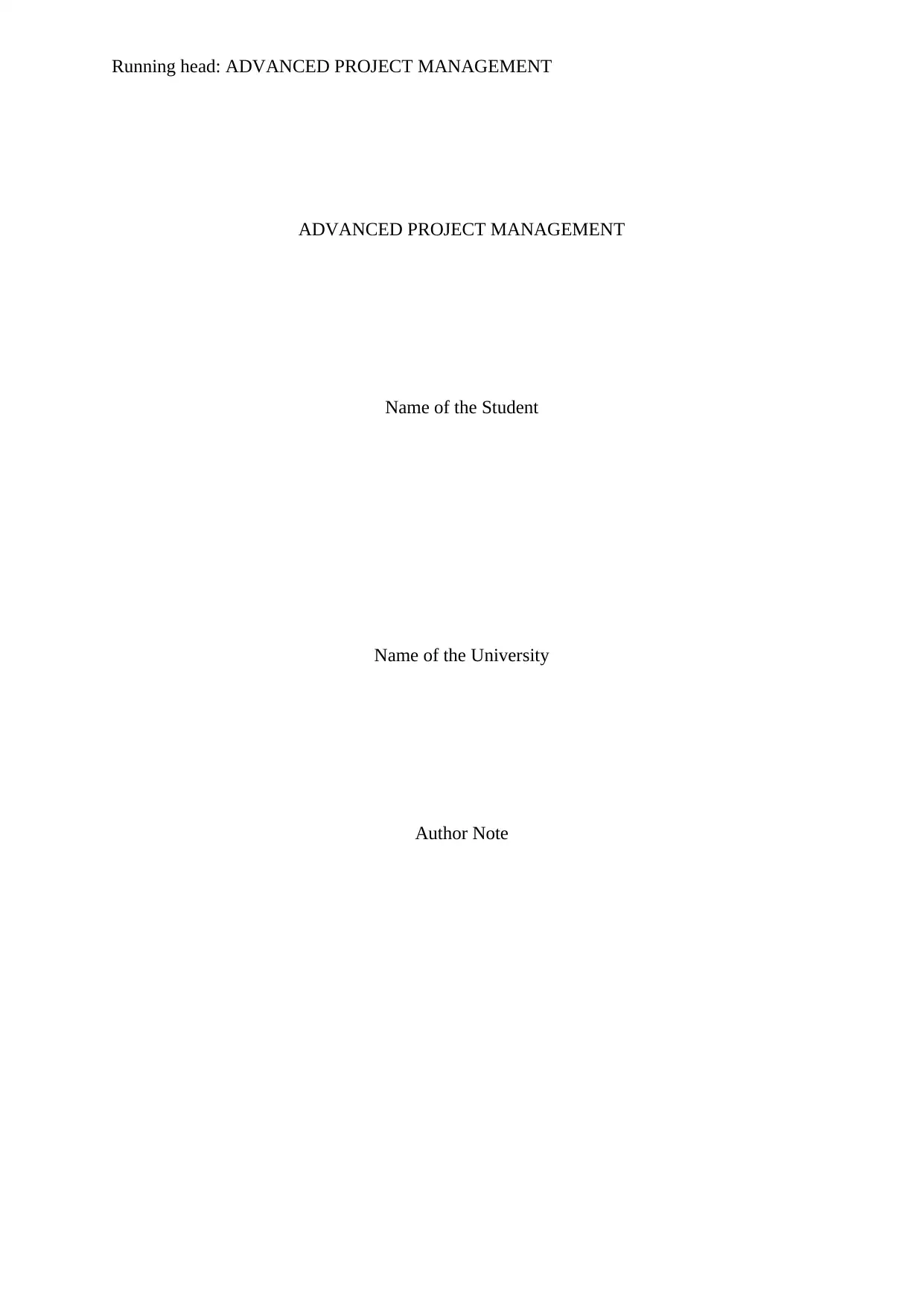
Running head: ADVANCED PROJECT MANAGEMENT
ADVANCED PROJECT MANAGEMENT
Name of the Student
Name of the University
Author Note
ADVANCED PROJECT MANAGEMENT
Name of the Student
Name of the University
Author Note
Paraphrase This Document
Need a fresh take? Get an instant paraphrase of this document with our AI Paraphraser
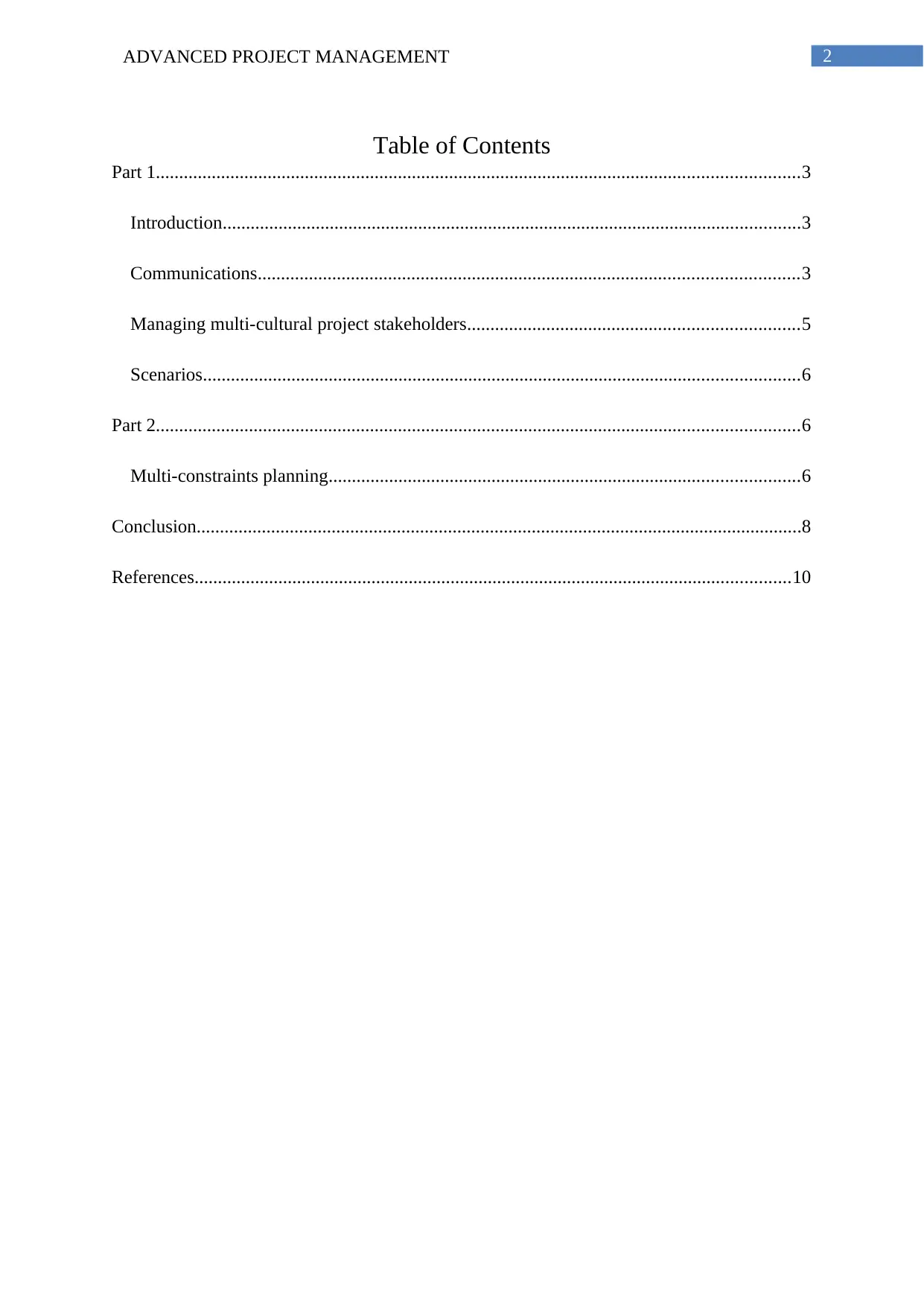
2ADVANCED PROJECT MANAGEMENT
Table of Contents
Part 1..........................................................................................................................................3
Introduction............................................................................................................................3
Communications....................................................................................................................3
Managing multi-cultural project stakeholders.......................................................................5
Scenarios................................................................................................................................6
Part 2..........................................................................................................................................6
Multi-constraints planning.....................................................................................................6
Conclusion..................................................................................................................................8
References................................................................................................................................10
Table of Contents
Part 1..........................................................................................................................................3
Introduction............................................................................................................................3
Communications....................................................................................................................3
Managing multi-cultural project stakeholders.......................................................................5
Scenarios................................................................................................................................6
Part 2..........................................................................................................................................6
Multi-constraints planning.....................................................................................................6
Conclusion..................................................................................................................................8
References................................................................................................................................10
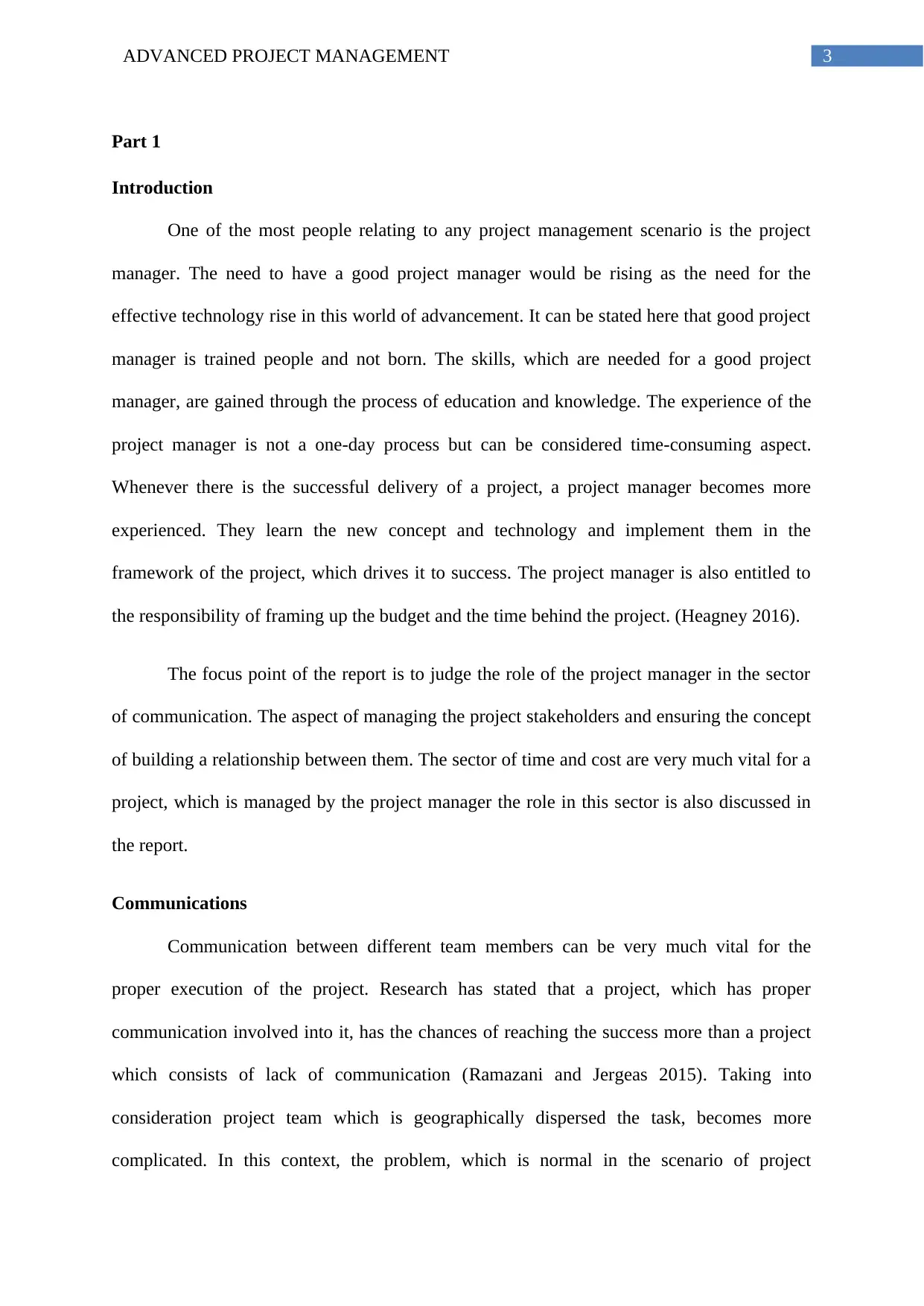
3ADVANCED PROJECT MANAGEMENT
Part 1
Introduction
One of the most people relating to any project management scenario is the project
manager. The need to have a good project manager would be rising as the need for the
effective technology rise in this world of advancement. It can be stated here that good project
manager is trained people and not born. The skills, which are needed for a good project
manager, are gained through the process of education and knowledge. The experience of the
project manager is not a one-day process but can be considered time-consuming aspect.
Whenever there is the successful delivery of a project, a project manager becomes more
experienced. They learn the new concept and technology and implement them in the
framework of the project, which drives it to success. The project manager is also entitled to
the responsibility of framing up the budget and the time behind the project. (Heagney 2016).
The focus point of the report is to judge the role of the project manager in the sector
of communication. The aspect of managing the project stakeholders and ensuring the concept
of building a relationship between them. The sector of time and cost are very much vital for a
project, which is managed by the project manager the role in this sector is also discussed in
the report.
Communications
Communication between different team members can be very much vital for the
proper execution of the project. Research has stated that a project, which has proper
communication involved into it, has the chances of reaching the success more than a project
which consists of lack of communication (Ramazani and Jergeas 2015). Taking into
consideration project team which is geographically dispersed the task, becomes more
complicated. In this context, the problem, which is normal in the scenario of project
Part 1
Introduction
One of the most people relating to any project management scenario is the project
manager. The need to have a good project manager would be rising as the need for the
effective technology rise in this world of advancement. It can be stated here that good project
manager is trained people and not born. The skills, which are needed for a good project
manager, are gained through the process of education and knowledge. The experience of the
project manager is not a one-day process but can be considered time-consuming aspect.
Whenever there is the successful delivery of a project, a project manager becomes more
experienced. They learn the new concept and technology and implement them in the
framework of the project, which drives it to success. The project manager is also entitled to
the responsibility of framing up the budget and the time behind the project. (Heagney 2016).
The focus point of the report is to judge the role of the project manager in the sector
of communication. The aspect of managing the project stakeholders and ensuring the concept
of building a relationship between them. The sector of time and cost are very much vital for a
project, which is managed by the project manager the role in this sector is also discussed in
the report.
Communications
Communication between different team members can be very much vital for the
proper execution of the project. Research has stated that a project, which has proper
communication involved into it, has the chances of reaching the success more than a project
which consists of lack of communication (Ramazani and Jergeas 2015). Taking into
consideration project team which is geographically dispersed the task, becomes more
complicated. In this context, the problem, which is normal in the scenario of project
⊘ This is a preview!⊘
Do you want full access?
Subscribe today to unlock all pages.

Trusted by 1+ million students worldwide
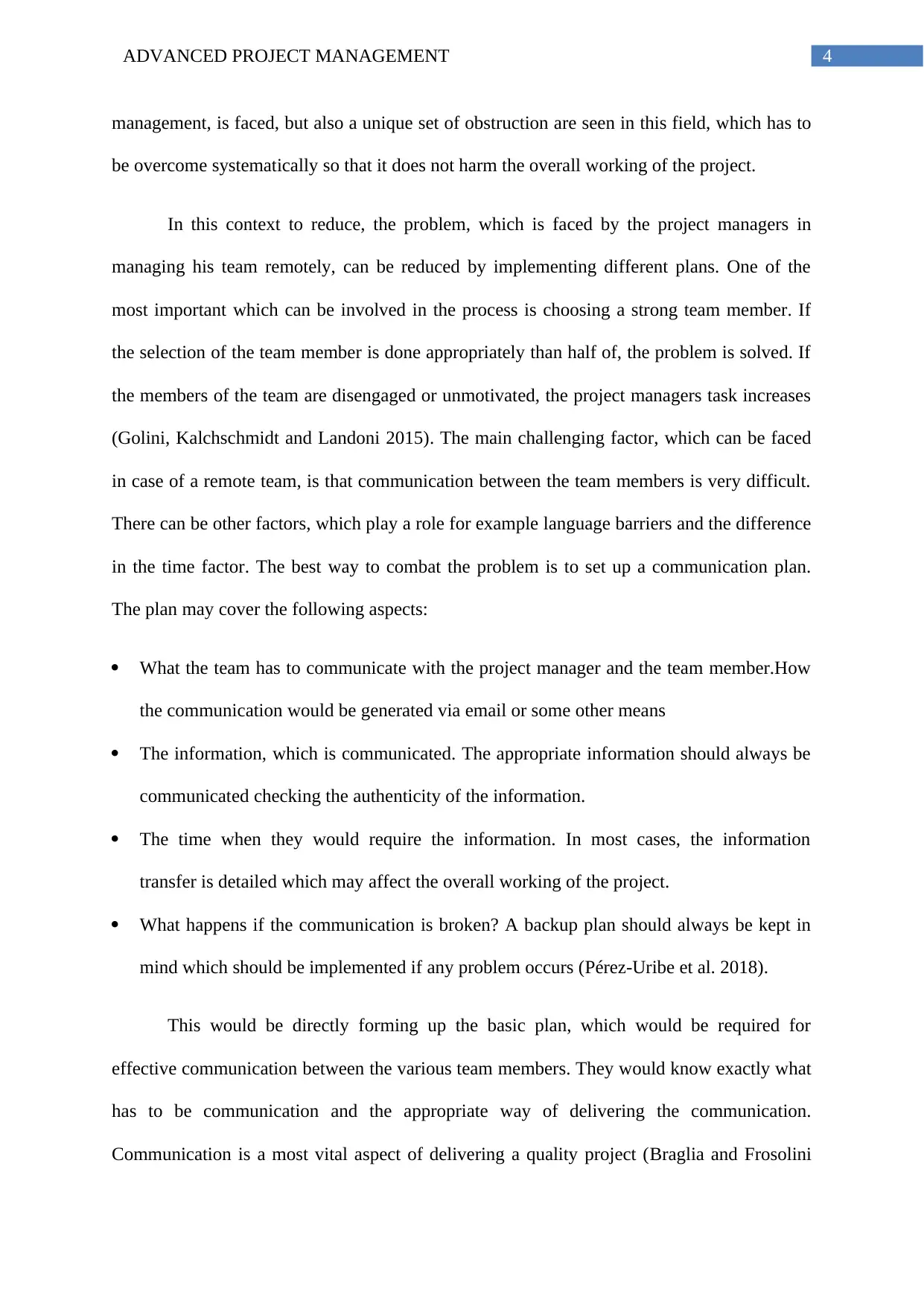
4ADVANCED PROJECT MANAGEMENT
management, is faced, but also a unique set of obstruction are seen in this field, which has to
be overcome systematically so that it does not harm the overall working of the project.
In this context to reduce, the problem, which is faced by the project managers in
managing his team remotely, can be reduced by implementing different plans. One of the
most important which can be involved in the process is choosing a strong team member. If
the selection of the team member is done appropriately than half of, the problem is solved. If
the members of the team are disengaged or unmotivated, the project managers task increases
(Golini, Kalchschmidt and Landoni 2015). The main challenging factor, which can be faced
in case of a remote team, is that communication between the team members is very difficult.
There can be other factors, which play a role for example language barriers and the difference
in the time factor. The best way to combat the problem is to set up a communication plan.
The plan may cover the following aspects:
What the team has to communicate with the project manager and the team member.How
the communication would be generated via email or some other means
The information, which is communicated. The appropriate information should always be
communicated checking the authenticity of the information.
The time when they would require the information. In most cases, the information
transfer is detailed which may affect the overall working of the project.
What happens if the communication is broken? A backup plan should always be kept in
mind which should be implemented if any problem occurs (Pérez-Uribe et al. 2018).
This would be directly forming up the basic plan, which would be required for
effective communication between the various team members. They would know exactly what
has to be communication and the appropriate way of delivering the communication.
Communication is a most vital aspect of delivering a quality project (Braglia and Frosolini
management, is faced, but also a unique set of obstruction are seen in this field, which has to
be overcome systematically so that it does not harm the overall working of the project.
In this context to reduce, the problem, which is faced by the project managers in
managing his team remotely, can be reduced by implementing different plans. One of the
most important which can be involved in the process is choosing a strong team member. If
the selection of the team member is done appropriately than half of, the problem is solved. If
the members of the team are disengaged or unmotivated, the project managers task increases
(Golini, Kalchschmidt and Landoni 2015). The main challenging factor, which can be faced
in case of a remote team, is that communication between the team members is very difficult.
There can be other factors, which play a role for example language barriers and the difference
in the time factor. The best way to combat the problem is to set up a communication plan.
The plan may cover the following aspects:
What the team has to communicate with the project manager and the team member.How
the communication would be generated via email or some other means
The information, which is communicated. The appropriate information should always be
communicated checking the authenticity of the information.
The time when they would require the information. In most cases, the information
transfer is detailed which may affect the overall working of the project.
What happens if the communication is broken? A backup plan should always be kept in
mind which should be implemented if any problem occurs (Pérez-Uribe et al. 2018).
This would be directly forming up the basic plan, which would be required for
effective communication between the various team members. They would know exactly what
has to be communication and the appropriate way of delivering the communication.
Communication is a most vital aspect of delivering a quality project (Braglia and Frosolini
Paraphrase This Document
Need a fresh take? Get an instant paraphrase of this document with our AI Paraphraser
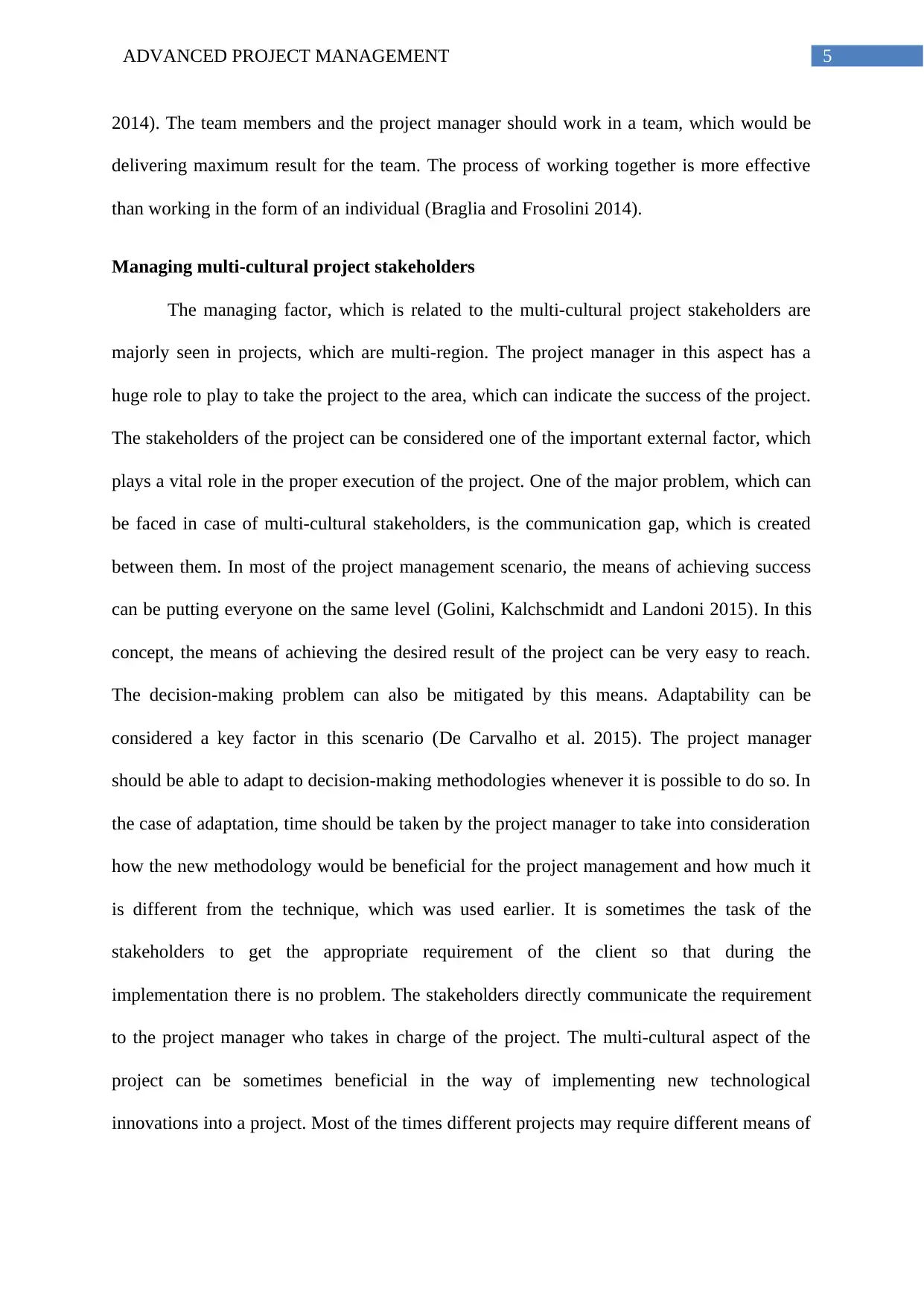
5ADVANCED PROJECT MANAGEMENT
2014). The team members and the project manager should work in a team, which would be
delivering maximum result for the team. The process of working together is more effective
than working in the form of an individual (Braglia and Frosolini 2014).
Managing multi-cultural project stakeholders
The managing factor, which is related to the multi-cultural project stakeholders are
majorly seen in projects, which are multi-region. The project manager in this aspect has a
huge role to play to take the project to the area, which can indicate the success of the project.
The stakeholders of the project can be considered one of the important external factor, which
plays a vital role in the proper execution of the project. One of the major problem, which can
be faced in case of multi-cultural stakeholders, is the communication gap, which is created
between them. In most of the project management scenario, the means of achieving success
can be putting everyone on the same level (Golini, Kalchschmidt and Landoni 2015). In this
concept, the means of achieving the desired result of the project can be very easy to reach.
The decision-making problem can also be mitigated by this means. Adaptability can be
considered a key factor in this scenario (De Carvalho et al. 2015). The project manager
should be able to adapt to decision-making methodologies whenever it is possible to do so. In
the case of adaptation, time should be taken by the project manager to take into consideration
how the new methodology would be beneficial for the project management and how much it
is different from the technique, which was used earlier. It is sometimes the task of the
stakeholders to get the appropriate requirement of the client so that during the
implementation there is no problem. The stakeholders directly communicate the requirement
to the project manager who takes in charge of the project. The multi-cultural aspect of the
project can be sometimes beneficial in the way of implementing new technological
innovations into a project. Most of the times different projects may require different means of
2014). The team members and the project manager should work in a team, which would be
delivering maximum result for the team. The process of working together is more effective
than working in the form of an individual (Braglia and Frosolini 2014).
Managing multi-cultural project stakeholders
The managing factor, which is related to the multi-cultural project stakeholders are
majorly seen in projects, which are multi-region. The project manager in this aspect has a
huge role to play to take the project to the area, which can indicate the success of the project.
The stakeholders of the project can be considered one of the important external factor, which
plays a vital role in the proper execution of the project. One of the major problem, which can
be faced in case of multi-cultural stakeholders, is the communication gap, which is created
between them. In most of the project management scenario, the means of achieving success
can be putting everyone on the same level (Golini, Kalchschmidt and Landoni 2015). In this
concept, the means of achieving the desired result of the project can be very easy to reach.
The decision-making problem can also be mitigated by this means. Adaptability can be
considered a key factor in this scenario (De Carvalho et al. 2015). The project manager
should be able to adapt to decision-making methodologies whenever it is possible to do so. In
the case of adaptation, time should be taken by the project manager to take into consideration
how the new methodology would be beneficial for the project management and how much it
is different from the technique, which was used earlier. It is sometimes the task of the
stakeholders to get the appropriate requirement of the client so that during the
implementation there is no problem. The stakeholders directly communicate the requirement
to the project manager who takes in charge of the project. The multi-cultural aspect of the
project can be sometimes beneficial in the way of implementing new technological
innovations into a project. Most of the times different projects may require different means of
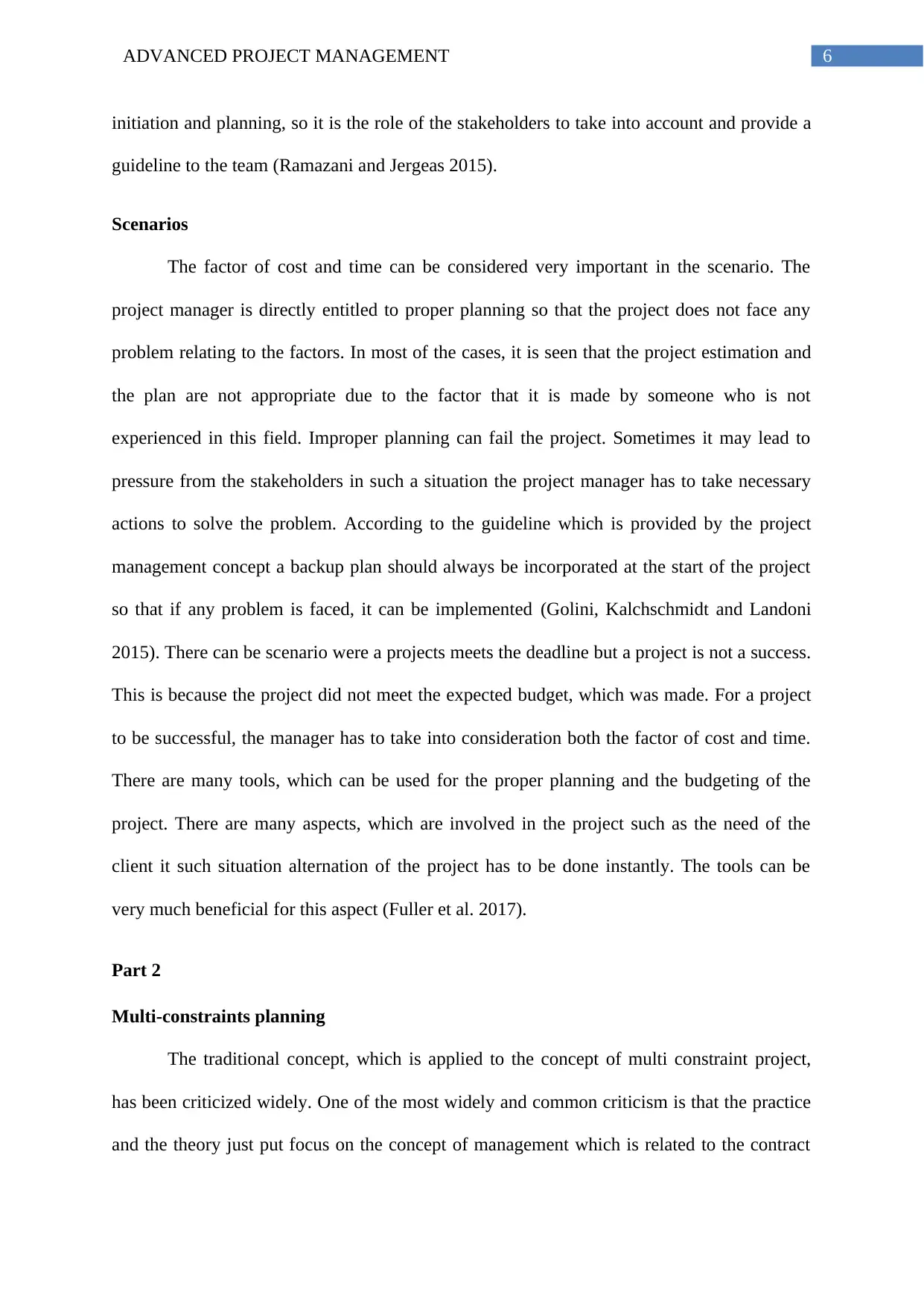
6ADVANCED PROJECT MANAGEMENT
initiation and planning, so it is the role of the stakeholders to take into account and provide a
guideline to the team (Ramazani and Jergeas 2015).
Scenarios
The factor of cost and time can be considered very important in the scenario. The
project manager is directly entitled to proper planning so that the project does not face any
problem relating to the factors. In most of the cases, it is seen that the project estimation and
the plan are not appropriate due to the factor that it is made by someone who is not
experienced in this field. Improper planning can fail the project. Sometimes it may lead to
pressure from the stakeholders in such a situation the project manager has to take necessary
actions to solve the problem. According to the guideline which is provided by the project
management concept a backup plan should always be incorporated at the start of the project
so that if any problem is faced, it can be implemented (Golini, Kalchschmidt and Landoni
2015). There can be scenario were a projects meets the deadline but a project is not a success.
This is because the project did not meet the expected budget, which was made. For a project
to be successful, the manager has to take into consideration both the factor of cost and time.
There are many tools, which can be used for the proper planning and the budgeting of the
project. There are many aspects, which are involved in the project such as the need of the
client it such situation alternation of the project has to be done instantly. The tools can be
very much beneficial for this aspect (Fuller et al. 2017).
Part 2
Multi-constraints planning
The traditional concept, which is applied to the concept of multi constraint project,
has been criticized widely. One of the most widely and common criticism is that the practice
and the theory just put focus on the concept of management which is related to the contract
initiation and planning, so it is the role of the stakeholders to take into account and provide a
guideline to the team (Ramazani and Jergeas 2015).
Scenarios
The factor of cost and time can be considered very important in the scenario. The
project manager is directly entitled to proper planning so that the project does not face any
problem relating to the factors. In most of the cases, it is seen that the project estimation and
the plan are not appropriate due to the factor that it is made by someone who is not
experienced in this field. Improper planning can fail the project. Sometimes it may lead to
pressure from the stakeholders in such a situation the project manager has to take necessary
actions to solve the problem. According to the guideline which is provided by the project
management concept a backup plan should always be incorporated at the start of the project
so that if any problem is faced, it can be implemented (Golini, Kalchschmidt and Landoni
2015). There can be scenario were a projects meets the deadline but a project is not a success.
This is because the project did not meet the expected budget, which was made. For a project
to be successful, the manager has to take into consideration both the factor of cost and time.
There are many tools, which can be used for the proper planning and the budgeting of the
project. There are many aspects, which are involved in the project such as the need of the
client it such situation alternation of the project has to be done instantly. The tools can be
very much beneficial for this aspect (Fuller et al. 2017).
Part 2
Multi-constraints planning
The traditional concept, which is applied to the concept of multi constraint project,
has been criticized widely. One of the most widely and common criticism is that the practice
and the theory just put focus on the concept of management which is related to the contract
⊘ This is a preview!⊘
Do you want full access?
Subscribe today to unlock all pages.

Trusted by 1+ million students worldwide
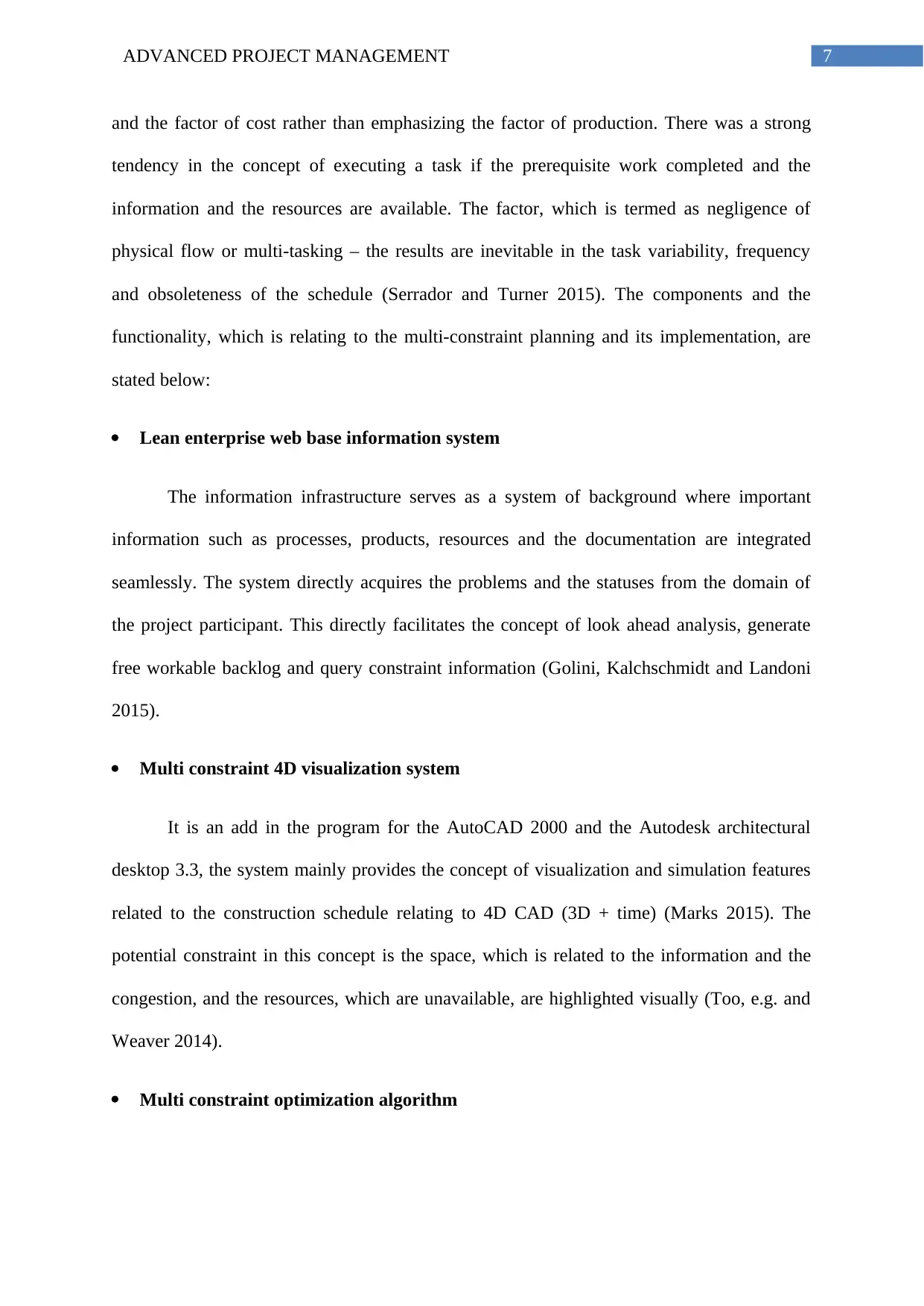
7ADVANCED PROJECT MANAGEMENT
and the factor of cost rather than emphasizing the factor of production. There was a strong
tendency in the concept of executing a task if the prerequisite work completed and the
information and the resources are available. The factor, which is termed as negligence of
physical flow or multi-tasking – the results are inevitable in the task variability, frequency
and obsoleteness of the schedule (Serrador and Turner 2015). The components and the
functionality, which is relating to the multi-constraint planning and its implementation, are
stated below:
Lean enterprise web base information system
The information infrastructure serves as a system of background where important
information such as processes, products, resources and the documentation are integrated
seamlessly. The system directly acquires the problems and the statuses from the domain of
the project participant. This directly facilitates the concept of look ahead analysis, generate
free workable backlog and query constraint information (Golini, Kalchschmidt and Landoni
2015).
Multi constraint 4D visualization system
It is an add in the program for the AutoCAD 2000 and the Autodesk architectural
desktop 3.3, the system mainly provides the concept of visualization and simulation features
related to the construction schedule relating to 4D CAD (3D + time) (Marks 2015). The
potential constraint in this concept is the space, which is related to the information and the
congestion, and the resources, which are unavailable, are highlighted visually (Too, e.g. and
Weaver 2014).
Multi constraint optimization algorithm
and the factor of cost rather than emphasizing the factor of production. There was a strong
tendency in the concept of executing a task if the prerequisite work completed and the
information and the resources are available. The factor, which is termed as negligence of
physical flow or multi-tasking – the results are inevitable in the task variability, frequency
and obsoleteness of the schedule (Serrador and Turner 2015). The components and the
functionality, which is relating to the multi-constraint planning and its implementation, are
stated below:
Lean enterprise web base information system
The information infrastructure serves as a system of background where important
information such as processes, products, resources and the documentation are integrated
seamlessly. The system directly acquires the problems and the statuses from the domain of
the project participant. This directly facilitates the concept of look ahead analysis, generate
free workable backlog and query constraint information (Golini, Kalchschmidt and Landoni
2015).
Multi constraint 4D visualization system
It is an add in the program for the AutoCAD 2000 and the Autodesk architectural
desktop 3.3, the system mainly provides the concept of visualization and simulation features
related to the construction schedule relating to 4D CAD (3D + time) (Marks 2015). The
potential constraint in this concept is the space, which is related to the information and the
congestion, and the resources, which are unavailable, are highlighted visually (Too, e.g. and
Weaver 2014).
Multi constraint optimization algorithm
Paraphrase This Document
Need a fresh take? Get an instant paraphrase of this document with our AI Paraphraser
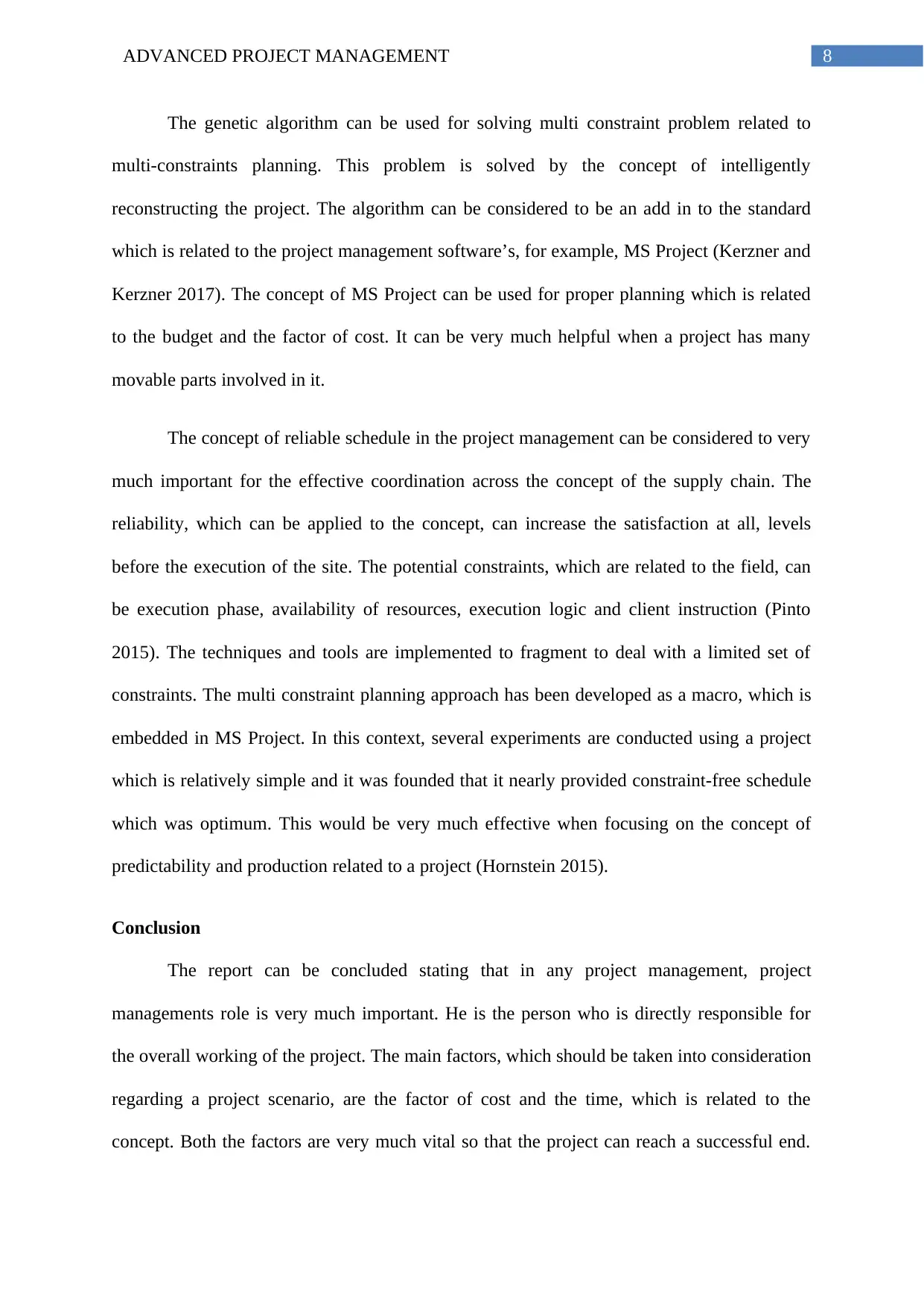
8ADVANCED PROJECT MANAGEMENT
The genetic algorithm can be used for solving multi constraint problem related to
multi-constraints planning. This problem is solved by the concept of intelligently
reconstructing the project. The algorithm can be considered to be an add in to the standard
which is related to the project management software’s, for example, MS Project (Kerzner and
Kerzner 2017). The concept of MS Project can be used for proper planning which is related
to the budget and the factor of cost. It can be very much helpful when a project has many
movable parts involved in it.
The concept of reliable schedule in the project management can be considered to very
much important for the effective coordination across the concept of the supply chain. The
reliability, which can be applied to the concept, can increase the satisfaction at all, levels
before the execution of the site. The potential constraints, which are related to the field, can
be execution phase, availability of resources, execution logic and client instruction (Pinto
2015). The techniques and tools are implemented to fragment to deal with a limited set of
constraints. The multi constraint planning approach has been developed as a macro, which is
embedded in MS Project. In this context, several experiments are conducted using a project
which is relatively simple and it was founded that it nearly provided constraint-free schedule
which was optimum. This would be very much effective when focusing on the concept of
predictability and production related to a project (Hornstein 2015).
Conclusion
The report can be concluded stating that in any project management, project
managements role is very much important. He is the person who is directly responsible for
the overall working of the project. The main factors, which should be taken into consideration
regarding a project scenario, are the factor of cost and the time, which is related to the
concept. Both the factors are very much vital so that the project can reach a successful end.
The genetic algorithm can be used for solving multi constraint problem related to
multi-constraints planning. This problem is solved by the concept of intelligently
reconstructing the project. The algorithm can be considered to be an add in to the standard
which is related to the project management software’s, for example, MS Project (Kerzner and
Kerzner 2017). The concept of MS Project can be used for proper planning which is related
to the budget and the factor of cost. It can be very much helpful when a project has many
movable parts involved in it.
The concept of reliable schedule in the project management can be considered to very
much important for the effective coordination across the concept of the supply chain. The
reliability, which can be applied to the concept, can increase the satisfaction at all, levels
before the execution of the site. The potential constraints, which are related to the field, can
be execution phase, availability of resources, execution logic and client instruction (Pinto
2015). The techniques and tools are implemented to fragment to deal with a limited set of
constraints. The multi constraint planning approach has been developed as a macro, which is
embedded in MS Project. In this context, several experiments are conducted using a project
which is relatively simple and it was founded that it nearly provided constraint-free schedule
which was optimum. This would be very much effective when focusing on the concept of
predictability and production related to a project (Hornstein 2015).
Conclusion
The report can be concluded stating that in any project management, project
managements role is very much important. He is the person who is directly responsible for
the overall working of the project. The main factors, which should be taken into consideration
regarding a project scenario, are the factor of cost and the time, which is related to the
concept. Both the factors are very much vital so that the project can reach a successful end.
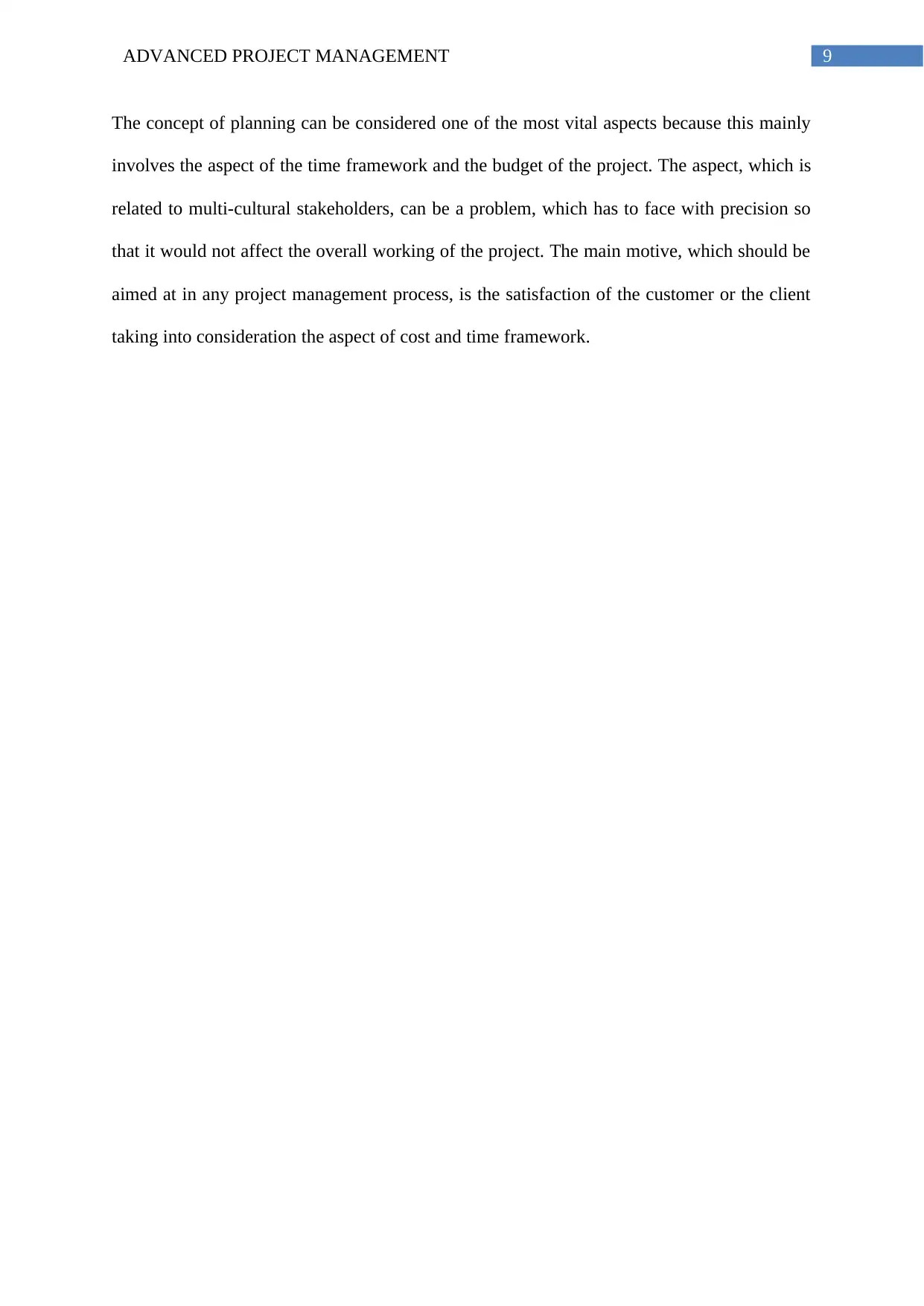
9ADVANCED PROJECT MANAGEMENT
The concept of planning can be considered one of the most vital aspects because this mainly
involves the aspect of the time framework and the budget of the project. The aspect, which is
related to multi-cultural stakeholders, can be a problem, which has to face with precision so
that it would not affect the overall working of the project. The main motive, which should be
aimed at in any project management process, is the satisfaction of the customer or the client
taking into consideration the aspect of cost and time framework.
The concept of planning can be considered one of the most vital aspects because this mainly
involves the aspect of the time framework and the budget of the project. The aspect, which is
related to multi-cultural stakeholders, can be a problem, which has to face with precision so
that it would not affect the overall working of the project. The main motive, which should be
aimed at in any project management process, is the satisfaction of the customer or the client
taking into consideration the aspect of cost and time framework.
⊘ This is a preview!⊘
Do you want full access?
Subscribe today to unlock all pages.

Trusted by 1+ million students worldwide
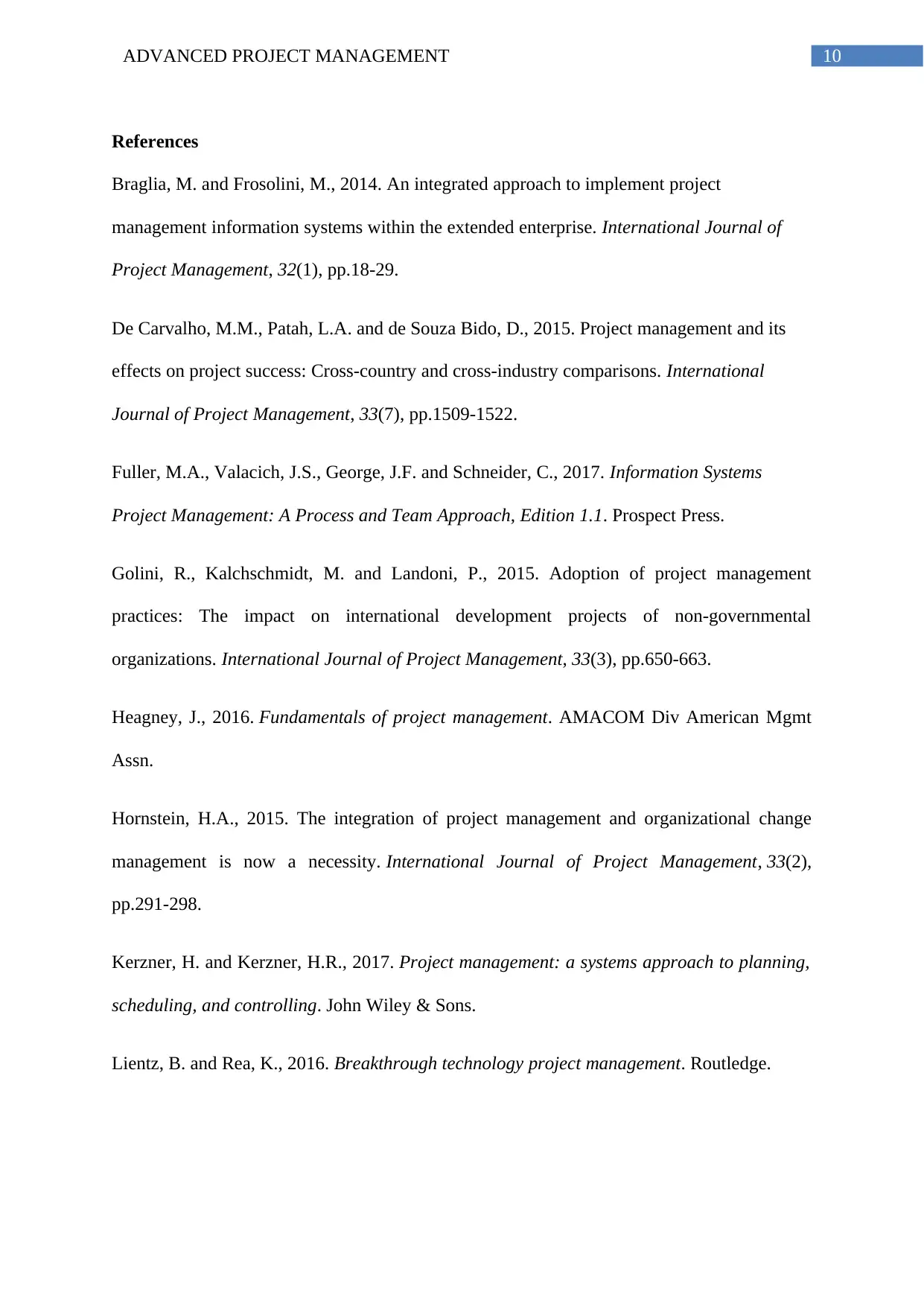
10ADVANCED PROJECT MANAGEMENT
References
Braglia, M. and Frosolini, M., 2014. An integrated approach to implement project
management information systems within the extended enterprise. International Journal of
Project Management, 32(1), pp.18-29.
De Carvalho, M.M., Patah, L.A. and de Souza Bido, D., 2015. Project management and its
effects on project success: Cross-country and cross-industry comparisons. International
Journal of Project Management, 33(7), pp.1509-1522.
Fuller, M.A., Valacich, J.S., George, J.F. and Schneider, C., 2017. Information Systems
Project Management: A Process and Team Approach, Edition 1.1. Prospect Press.
Golini, R., Kalchschmidt, M. and Landoni, P., 2015. Adoption of project management
practices: The impact on international development projects of non-governmental
organizations. International Journal of Project Management, 33(3), pp.650-663.
Heagney, J., 2016. Fundamentals of project management. AMACOM Div American Mgmt
Assn.
Hornstein, H.A., 2015. The integration of project management and organizational change
management is now a necessity. International Journal of Project Management, 33(2),
pp.291-298.
Kerzner, H. and Kerzner, H.R., 2017. Project management: a systems approach to planning,
scheduling, and controlling. John Wiley & Sons.
Lientz, B. and Rea, K., 2016. Breakthrough technology project management. Routledge.
References
Braglia, M. and Frosolini, M., 2014. An integrated approach to implement project
management information systems within the extended enterprise. International Journal of
Project Management, 32(1), pp.18-29.
De Carvalho, M.M., Patah, L.A. and de Souza Bido, D., 2015. Project management and its
effects on project success: Cross-country and cross-industry comparisons. International
Journal of Project Management, 33(7), pp.1509-1522.
Fuller, M.A., Valacich, J.S., George, J.F. and Schneider, C., 2017. Information Systems
Project Management: A Process and Team Approach, Edition 1.1. Prospect Press.
Golini, R., Kalchschmidt, M. and Landoni, P., 2015. Adoption of project management
practices: The impact on international development projects of non-governmental
organizations. International Journal of Project Management, 33(3), pp.650-663.
Heagney, J., 2016. Fundamentals of project management. AMACOM Div American Mgmt
Assn.
Hornstein, H.A., 2015. The integration of project management and organizational change
management is now a necessity. International Journal of Project Management, 33(2),
pp.291-298.
Kerzner, H. and Kerzner, H.R., 2017. Project management: a systems approach to planning,
scheduling, and controlling. John Wiley & Sons.
Lientz, B. and Rea, K., 2016. Breakthrough technology project management. Routledge.
Paraphrase This Document
Need a fresh take? Get an instant paraphrase of this document with our AI Paraphraser
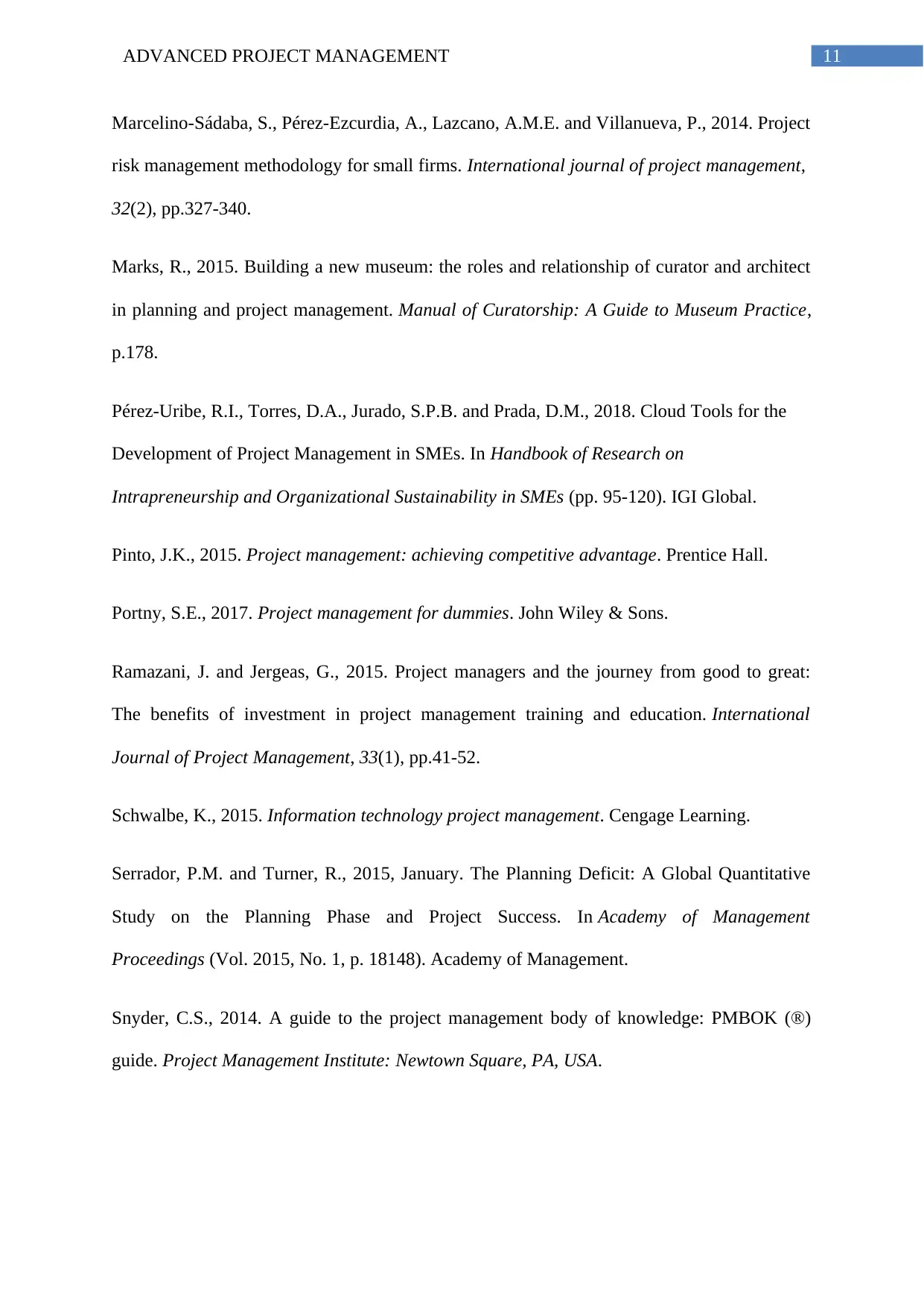
11ADVANCED PROJECT MANAGEMENT
Marcelino-Sádaba, S., Pérez-Ezcurdia, A., Lazcano, A.M.E. and Villanueva, P., 2014. Project
risk management methodology for small firms. International journal of project management,
32(2), pp.327-340.
Marks, R., 2015. Building a new museum: the roles and relationship of curator and architect
in planning and project management. Manual of Curatorship: A Guide to Museum Practice,
p.178.
Pérez-Uribe, R.I., Torres, D.A., Jurado, S.P.B. and Prada, D.M., 2018. Cloud Tools for the
Development of Project Management in SMEs. In Handbook of Research on
Intrapreneurship and Organizational Sustainability in SMEs (pp. 95-120). IGI Global.
Pinto, J.K., 2015. Project management: achieving competitive advantage. Prentice Hall.
Portny, S.E., 2017. Project management for dummies. John Wiley & Sons.
Ramazani, J. and Jergeas, G., 2015. Project managers and the journey from good to great:
The benefits of investment in project management training and education. International
Journal of Project Management, 33(1), pp.41-52.
Schwalbe, K., 2015. Information technology project management. Cengage Learning.
Serrador, P.M. and Turner, R., 2015, January. The Planning Deficit: A Global Quantitative
Study on the Planning Phase and Project Success. In Academy of Management
Proceedings (Vol. 2015, No. 1, p. 18148). Academy of Management.
Snyder, C.S., 2014. A guide to the project management body of knowledge: PMBOK (®)
guide. Project Management Institute: Newtown Square, PA, USA.
Marcelino-Sádaba, S., Pérez-Ezcurdia, A., Lazcano, A.M.E. and Villanueva, P., 2014. Project
risk management methodology for small firms. International journal of project management,
32(2), pp.327-340.
Marks, R., 2015. Building a new museum: the roles and relationship of curator and architect
in planning and project management. Manual of Curatorship: A Guide to Museum Practice,
p.178.
Pérez-Uribe, R.I., Torres, D.A., Jurado, S.P.B. and Prada, D.M., 2018. Cloud Tools for the
Development of Project Management in SMEs. In Handbook of Research on
Intrapreneurship and Organizational Sustainability in SMEs (pp. 95-120). IGI Global.
Pinto, J.K., 2015. Project management: achieving competitive advantage. Prentice Hall.
Portny, S.E., 2017. Project management for dummies. John Wiley & Sons.
Ramazani, J. and Jergeas, G., 2015. Project managers and the journey from good to great:
The benefits of investment in project management training and education. International
Journal of Project Management, 33(1), pp.41-52.
Schwalbe, K., 2015. Information technology project management. Cengage Learning.
Serrador, P.M. and Turner, R., 2015, January. The Planning Deficit: A Global Quantitative
Study on the Planning Phase and Project Success. In Academy of Management
Proceedings (Vol. 2015, No. 1, p. 18148). Academy of Management.
Snyder, C.S., 2014. A guide to the project management body of knowledge: PMBOK (®)
guide. Project Management Institute: Newtown Square, PA, USA.
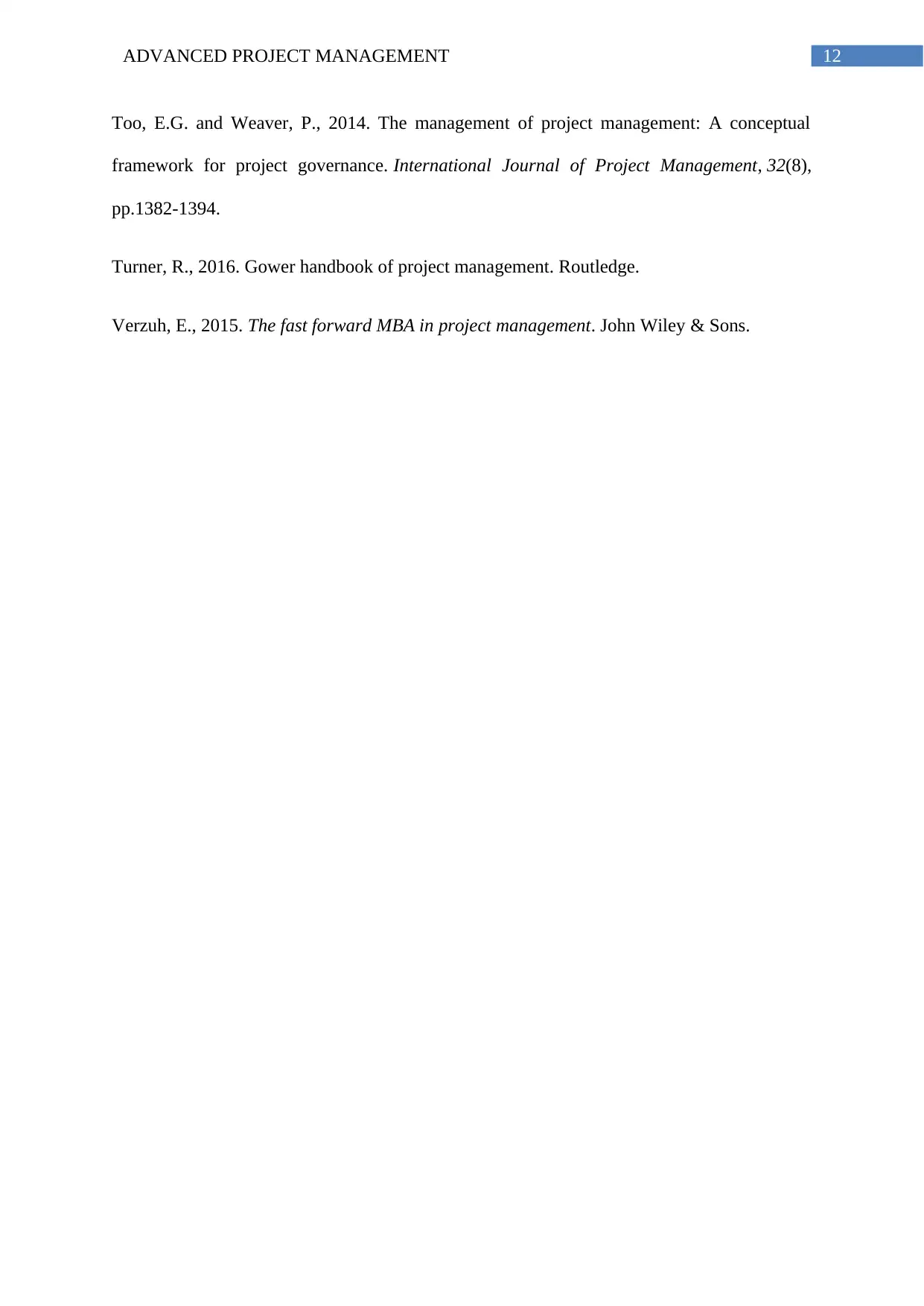
12ADVANCED PROJECT MANAGEMENT
Too, E.G. and Weaver, P., 2014. The management of project management: A conceptual
framework for project governance. International Journal of Project Management, 32(8),
pp.1382-1394.
Turner, R., 2016. Gower handbook of project management. Routledge.
Verzuh, E., 2015. The fast forward MBA in project management. John Wiley & Sons.
Too, E.G. and Weaver, P., 2014. The management of project management: A conceptual
framework for project governance. International Journal of Project Management, 32(8),
pp.1382-1394.
Turner, R., 2016. Gower handbook of project management. Routledge.
Verzuh, E., 2015. The fast forward MBA in project management. John Wiley & Sons.
⊘ This is a preview!⊘
Do you want full access?
Subscribe today to unlock all pages.

Trusted by 1+ million students worldwide
1 out of 12
Related Documents
Your All-in-One AI-Powered Toolkit for Academic Success.
+13062052269
info@desklib.com
Available 24*7 on WhatsApp / Email
![[object Object]](/_next/static/media/star-bottom.7253800d.svg)
Unlock your academic potential
Copyright © 2020–2025 A2Z Services. All Rights Reserved. Developed and managed by ZUCOL.





